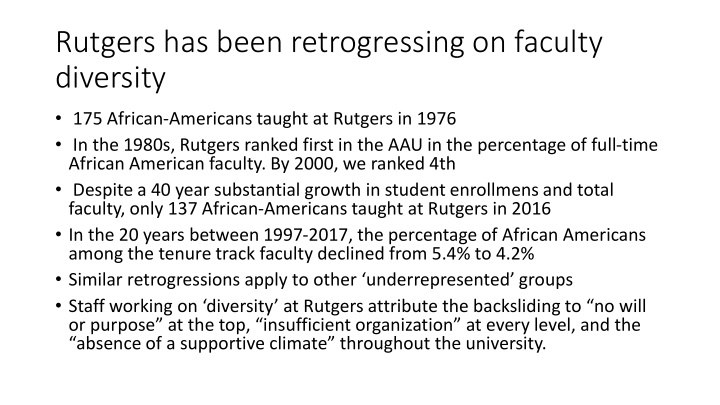



Rutgers has been retrogressing on faculty diversity • 175 African-Americans taught at Rutgers in 1976 • In the 1980s, Rutgers ranked first in the AAU in the percentage of full-time African American faculty. By 2000, we ranked 4th • Despite a 40 year substantial growth in student enrollmens and total faculty, only 137 African-Americans taught at Rutgers in 2016 • In the 20 years between 1997-2017, the percentage of African Americans among the tenure track faculty declined from 5.4% to 4.2% • Si�ilar retrogressio�s apply to other �u�derreprese�ted� groups • Staff �orki�g o� �di�ersity� at Rutgers attri�ute the �a�kslidi�g to ��o �ill or purpose� at the top, �i�suffi�ie�t orga�izatio�� at e�ery le�el, a�d the �a�se��e of a supporti�e �li�ate� throughout the u�i�ersity.
Dismemberment of a successful program • Rutgers� di�ersity progress i� the ����s a�d early ����s �as due to the need to comply with a federal consent decree that required demonstrable progress – authenticated by numerical goals, timetables, data collection and regular reporting • During the 20 years after Washington backtracked on its strict requirements, the Rutgers administration systematically dismantled all of the policies and programs that had previously yielded positive diversity results • During the dismantling period, Rutgers disingenuously masked its substantial retreat by only comparing its numbers to the diversity numbers of other AAU universities. It completely ignored its own 1970s record. In reality, AAU i�stitutio�s ha�e �ee� a�o�g the �atio��s least di�erse, �ost historically resistant to progressive change and most of them were not mandated to serve as diverse a population as Rutgers
What worked when Rutgers had to be serious about diversity The university leadership: • Created a highly visible, expertly staffed, well-funded and administratively powerful office to manage the task (The Office of Affirmative Action and Employment Research) • Instituted a system of sanctions for departments failing to achieve satisfactory progress with �di�ersity� • Made new faculty lines available for academic departments on condition that they hired people of color and/or women • Created and funded the Minority Faculty Development Program to help the tenure prospects of African American and Latino American professors • Established procedures requiring the affirmative-action officer's written approval before a new hire or promotion could occur • Created a supporti�e �li�ate for �di�ersity� i� �hi�h the U�i�ersity preside�t se�t a� a��ual memorandum to all University employees reaffirming the University's commitment to equal opportu�ity a�d affir�ati�e a�tio� a�d e��losi�g a report o� the U�i�ersity�s progress.
Recommend
More recommend